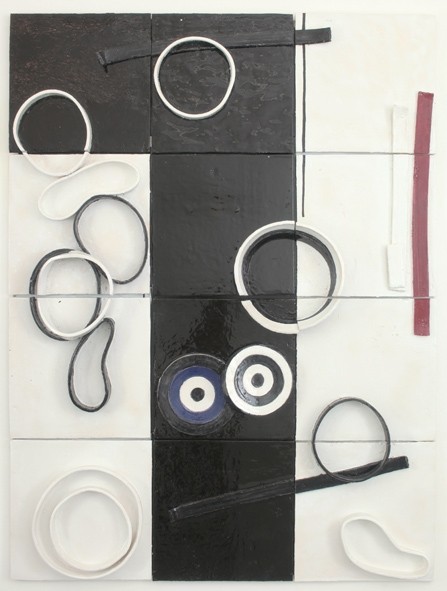Fabian Marti
21 Oct - 02 Dec 2011
And Then We Mad
Galleria Fonti is pleased to announce the second solo exhibition in the gallery of Swiss artist Fabian Marti.
The works realized for the exhibition (photograms, ceramic sculptures, a wall installation made with twelve tiles of ceramics) are related to a group currently in show at ILLUMInazioni/ILLUMInations-54th La Biennale di Venezia and due to be exhibited, in occasion of a solo show, at KunstvereinBraunschweig, Germany in the next December.
The title of the exhibition, And then We Mad, is drawn from a passage of the book True Hallucinations by Terence McKenna, an autobiographical recounting where the author had the courage and the integrity to describe with fairly rigorous thoroughness a series of experiences he and his brother had in the Amazon jungles with psychedelic mushrooms:
«And then we made love. Or rather we had an experience that vaguely related to making love but was a thing unto itself. We were both howling and singing in the glossolalia of DMT, rolling over the ground with everything awash in crawling, geometric hallucinations. She was transformed; words exist to describe what she became— pure anima, Kali, Leucothea, something erotic but not human, something addressed to the species and not to the individual, glittering with the possibility of cannibalism, madness, space, and extinction. She seemed on the edge of devouring me».
In this new project the art research by Fabian Marti focuses on altered states of consciousness as his works emerge out of the experience he had with mind altering drugs: the artist uses that condition asa key to understand where we humans come from, how culture emerged and when the use of language was born.
The altered states can also help us to solve the problems we face in life since they have the characteristic to be “ego - dissolving”.
Again a link to McKenna, to his Stone Ape Theory in which he proposed that the transformation from humans' early ancestors Homo erectust o the species Homo sapiens mainly had to do with the addition of the mushroom Psilocybe cubensis in its diet.
Thefive ceramic vases and the high relief of a deconstructed vase shown in the gallery could be looked at as doorways into other states of mind; as madness machines and at the same time the product of madness machines.
Three big size photograms are placed in the first and second room of the gallery, together with other six small size photograms.
These works are realized placing strings of tape and transparencies of digitally conceived designs directly onto the surface of a photo-sensitive material (silver-gelatin paper) and then exposing it to light, sometimes adding colored ink, merging analog and digital photo processes.
Galleria Fonti is pleased to announce the second solo exhibition in the gallery of Swiss artist Fabian Marti.
The works realized for the exhibition (photograms, ceramic sculptures, a wall installation made with twelve tiles of ceramics) are related to a group currently in show at ILLUMInazioni/ILLUMInations-54th La Biennale di Venezia and due to be exhibited, in occasion of a solo show, at KunstvereinBraunschweig, Germany in the next December.
The title of the exhibition, And then We Mad, is drawn from a passage of the book True Hallucinations by Terence McKenna, an autobiographical recounting where the author had the courage and the integrity to describe with fairly rigorous thoroughness a series of experiences he and his brother had in the Amazon jungles with psychedelic mushrooms:
«And then we made love. Or rather we had an experience that vaguely related to making love but was a thing unto itself. We were both howling and singing in the glossolalia of DMT, rolling over the ground with everything awash in crawling, geometric hallucinations. She was transformed; words exist to describe what she became— pure anima, Kali, Leucothea, something erotic but not human, something addressed to the species and not to the individual, glittering with the possibility of cannibalism, madness, space, and extinction. She seemed on the edge of devouring me».
In this new project the art research by Fabian Marti focuses on altered states of consciousness as his works emerge out of the experience he had with mind altering drugs: the artist uses that condition asa key to understand where we humans come from, how culture emerged and when the use of language was born.
The altered states can also help us to solve the problems we face in life since they have the characteristic to be “ego - dissolving”.
Again a link to McKenna, to his Stone Ape Theory in which he proposed that the transformation from humans' early ancestors Homo erectust o the species Homo sapiens mainly had to do with the addition of the mushroom Psilocybe cubensis in its diet.
Thefive ceramic vases and the high relief of a deconstructed vase shown in the gallery could be looked at as doorways into other states of mind; as madness machines and at the same time the product of madness machines.
Three big size photograms are placed in the first and second room of the gallery, together with other six small size photograms.
These works are realized placing strings of tape and transparencies of digitally conceived designs directly onto the surface of a photo-sensitive material (silver-gelatin paper) and then exposing it to light, sometimes adding colored ink, merging analog and digital photo processes.

